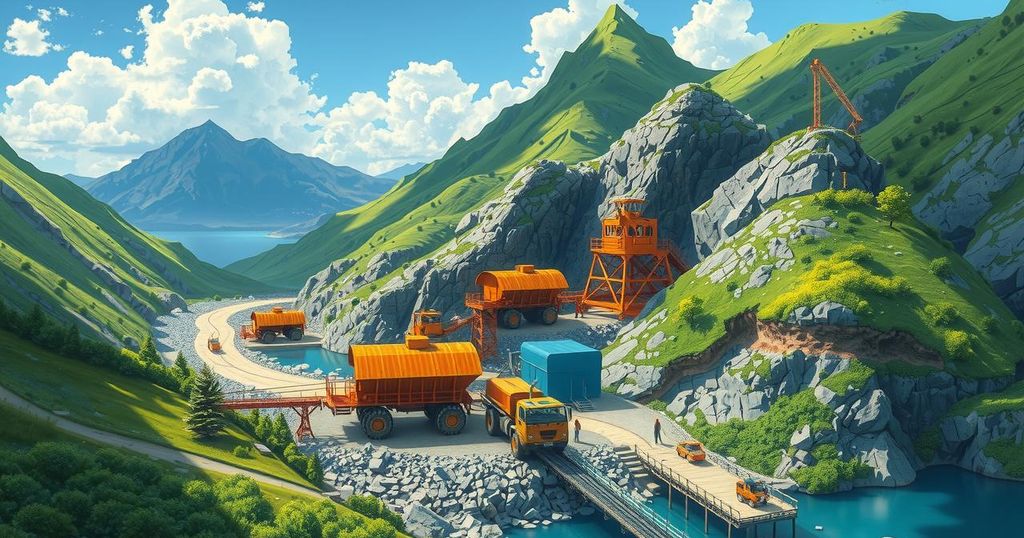The Government of Liberia has requested ArcelorMittal Liberia to permit Ivanhoe Atlantic to conduct an Environmental and Social Impact Assessment along the Yekepa-Buchanan railway, signalling a commitment to a multiuser rail policy. The move will potentially open the railway to other companies, aimed at enhancing economic growth and regulatory compliance. If implemented, this policy will signify a move away from AML’s existing monopoly, encouraging broader investment and participation in the sector.
The Government of Liberia has officially requested ArcelorMittal Liberia (AML) to grant Ivanhoe Atlantic access for an Environmental and Social Impact Assessment (ESIA) along the Yekepa-Buchanan railway. This action represents a significant commitment to implementing a multiuser rail policy aimed at maximizing economic advantages and ensuring compliance with regulatory frameworks. The letters issued by the Ministry of Mines and Energy and the Ministry of Transport highlight this initiative’s importance for Liberia’s railway infrastructure.
Addressed to AML CEO Michiel van der Merwe, the letters specify that Ivanhoe Atlantic’s ESIA is scheduled for March 17–21, 2025. The Ministry of Mines and Energy emphasizes Ivanhoe Atlantic’s legal entitlement under the Mineral Development Agreement (MDA) of 2005 to conduct the assessment, as part of its due diligence. The Ministry of Transport reinforced this position, noting that the Environmental Protection Agency (EPA) mandates the ESIA as essential for Ivanhoe’s operational plans.
The Yekepa-Buchanan railway, critical for iron ore exports, has traditionally been managed exclusively by AML as per its MDA, restricting access for other firms. However, the government’s move to institute a multiuser rail policy represents a significant policy shift aimed at generating additional revenue through increased utilization of the railway infrastructure. This could enhance economic collaborations and operational dynamics among multiple mining firms.
An ESIA assesses the environmental, social, and economic impacts prior to the commencement of large-scale industrial projects. This study will evaluate various concerns, including community impacts, environmental risks such as deforestation and pollution, and the capability of existing railway infrastructure to support increased traffic. For communities, this provides a foundation for economic development, in contrast to past operations, which were criticized for their limited local benefits.
The government’s directive raises challenges for AML, which has resisted multiuser rail initiatives, claiming exclusive rights under its MDA. Nevertheless, it is determined that AML does not possess the legal authority to impede an ESIA, as this falls within the regulatory framework mandated by the government. Previous legal opinions have affirmed the government’s sovereign right to expand rail access.
This directive is also significant for potential investors. Liberian authorities are emphasizing openness and competitive practices in infrastructure usage, which could attract more investment in the mining sector. As Ivanhoe Atlantic proceeds with its ESIA, the assurance of breaking previous monopolies may incentivize other companies to engage with Liberia’s market.
Next steps involve AML choosing to comply with the ESIA directive, thereby adapting to a multiuser rail framework, or resisting, which could escalate tensions. The involvement of Ministry of Transport officials in the ESIA oversight suggests that AML may face limitations on obstructing the process. Concurrently, Ivanhoe Atlantic may also begin preparing studies for new rail projects that could diversify the use of rail infrastructure.
Liberia’s initiative to advance toward conducting an ESIA for Ivanhoe Atlantic represents a pivotal movement in its economic evolution. It signals a serious commitment to establishing an inclusive infrastructure approach that benefits various stakeholders and enhances the overall competitive landscape in the business environment of Liberia.
In conclusion, Liberia’s forward momentum in granting Ivanhoe Atlantic access for an Environmental and Social Impact Assessment marks a transformative step toward implementing its multiuser rail policy. This decision reflects the government’s initiative to diversify economic benefits across multiple stakeholders, challenge monopolistic practices of AML, and attract international investments. The outcome will significantly impact the future landscape of Liberia’s mining and transport sectors.
Original Source: www.liberianobserver.com




